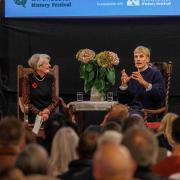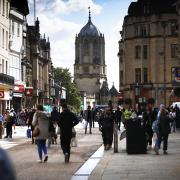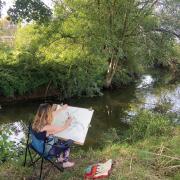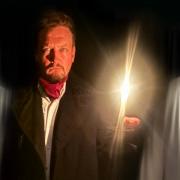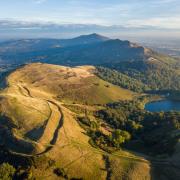Long before Gloucester was a twinkle in an imperial Roman eye, a tower was built on one of the willow-fringed islands by the River Severn. This tower stretched tall into the sky, and was as deep below the earth as it was high. It was built to house but one prisoner, and he had been there since he was three days old. His name was Mabon, and, according to the Welsh Triads, he was one of the three exalted prisoners of Britain.
Mabon’s story is told in the collection of medieval Welsh tales now called The Mabinogion. These texts may have originated as oral stories, and were written down probably between the 12th and 15th centuries. Mabon’s tale comes from the tale of ‘Culhwch and Olwen’, in which Culhwch is cursed to marry no one but Olwen, the daughter of curmudgeonly giant Ysbaddaden. The giant himself is hard to find, but with the help of Culhwch’s uncle, King Arthur, he’s tracked down in north Wales. Ysbaddaden will only let Olwen marry if Culhwch completes no fewer than 40 quests. This includes hunting down the giant boar Twrch Trwyth, and extracting the comb, razor and scissors that sit between its ears, as Ysbaddaden needed his hair trimming before he would see his daughter married. This one quest has a number of side quests, and cannot be completed without the hunter, Mabon son of Modron, who was taken from his mother when he was three days old and hadn’t been seen since.
In this tale, perhaps composed as early as the 10th century, Arthur and his warriors come to Culhwch’s aid. They are more like gods than men, with superhuman strength and knowledge; but they have no idea how to find Mabon. They are given a clue: ask the oldest of all the animals. Thus begins a quest for that beast that takes them across western Britain. First to the Wirral, where they meet the Blackbird of Kilgwri, who has been there so long that she has worn down an anvil by wiping her beak against each night – but old though she is, she has not heard of Mabon. Then to the Stag of Rendenvre in Cheshire, who is old enough to have seen an oak tree grow and die. He sends them on to the Owl of Cwm Cowlyd, in Snowdonia, who has seen three forests come and go. The Owl sends them to the Eagle of Gwernabwy in Ceredigion, who has flown to the top of a great mountain each night to peck the stars. That mountain is now a pebble, but he too has never heard of Mabon. But does know one animal who is older than him: the Salmon of Llyn Llaw. In these animals we see different ages: the blackbird seeming to represent the life of men; the stag the greater life of trees; the owl how the land changes as the climate ebbs and flows; the eagle geological time – and the salmon, the Celtic fount of all knowledge, older than all those.

This oldest of all the animals tells Culhwch, Arthur and his men that he sometimes swims up with the tide to Caer Gloyw, the shining fortress that we know as Gloucester, and there he has seen such evil there as you would not believe, and heard great lamentation. Our heroes hitch a lift on the salmon’s back and, as they approach Gloucester, see the tower rising above the river as the tower of the cathedral does today. This being a heroic tale, Mabon is freed by fighting!
With Mabon by their side, they can now hunt the boar and get the hairdressing tools it carries. Twrch Trwyth is a tricky customer, and leads them all round Britain, over the sea to Ireland and back again through Wales. Arthur battles the boar many times, and loses many of his men. At the confluence of the Wye and the Severn at Beachley Point they corner him, and there retrieve the razor and scissors. The boar breaks free of their clutches, and swims across to Aust. But Arthur is canny, and has sent a contingent of men there against this very eventuality – but Twrch Trwyth escapes once more and races south into Cornwall, where, at last, they manage to grab the comb before the boar falls over a cliff into the sea.

This tale shows how much the western counties of England are part of the medieval Welsh imaginary. Gloucestershire appears in other tales in The Mabinogion. Pyderi, one of the heroes of the third branch, ‘Manawydan son of Llyr’, marries Kigfa, daughter of the king of Caer Gloyw. She’s a feisty and often exasperated heroine. A hero of another tale, Peredur, must defeat the nine hags of Gloucester. These warrior women have terrorised every castle in the land – until Peredur comes along. After defeating one of them, they take him back to their fortress at Gloucester where they train him in arms. Like with Ysbaddaden, the hags have no choice but to train him, even though they know one day he is fated to destroy them.
It's hard to get a sense of the landscape that early medieval Gloucester today, but if you head out in the walk below onto Alney Island amid the long grass, the waving reeds and the rustling willows, and look out to the tall tower of the cathedral, perhaps you can capture, for a moment, what the land was like in those far off medieval times. Maybe you’ll get an echo, while you’re there, of the even more ancient lands witnessed by those oldest of all the animals.
COMPASS POINTS
Distance: 3 miles.
Duration: 1 hour.
Level: Easy, a mix of paved and dirt paths.
Parking: Car parks in Gloucester
Toilets and refreshments: I went to DeliGreek, by the river lock on Gloucester Docks.
Transport: Easy public transport links to Gloucester, both rail and bus.
LINKS
Route: https://gb.mapometer.com/walking/route_5544245.html
FURTHER READING:
The Mabinogion translated by Jeffrey Gantz (Penguin Books, 1976)
Gloucestershire Folk Tales by Anthony Nanson (History Press, 2012)
Kirsty Hartsiotis is based in Stroud and available for hire as a storyteller and speaker. She is an accredited Arts Society lecturer. Her books include Wiltshire Folk Tales and (with Anthony Nanson) Gloucestershire Ghost Tales and Gloucestershire Folk Tales for Children. She is also a curator at Swindon Museums.










